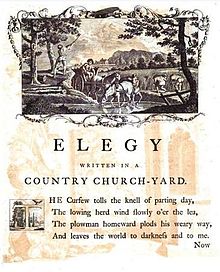
Back رثاء مكتوب في ساحة الكنيسة الريفية Arabic Elegy Written in a Country Churchyard Breton Élégie écrite dans un cimetière de campagne French Elegia scritta in un cimitero campestre Italian എലിജി റിട്ടൻ ഇൻ എ കൻട്രി ചർച്ച്യാർഡ് Malayalam Elegy Written in a Country Churchyard Dutch ਐਲਜੀ ਰਿਟਨ ਇਨ ਅ ਕੰਟਰੀ ਚਰਚਯਾਰਡ Punjabi Elegia napisana na wiejskim cmentarzu Polish

Elegy Written in a Country Churchyard is a poem by Thomas Gray, completed in 1750 and first published in 1751.[1] The poem's origins are unknown, but it was partly inspired by Gray's thoughts following the death of the poet Richard West in 1742. Originally titled Stanzas Wrote in a Country Church-Yard, the poem was completed when Gray was living near the Church of St Giles, Stoke Poges. It was sent to his friend Horace Walpole, who popularised the poem among London literary circles. Gray was eventually forced to publish the work on 15 February 1751 in order to preempt a magazine publisher from printing an unlicensed copy of the poem.
The poem is an elegy in name but not in form; it employs a style similar to that of contemporary odes, but it embodies a meditation on death, and remembrance after death. The poem argues that the remembrance can be good and bad, and the narrator finds comfort in pondering the lives of the obscure rustics buried in the churchyard. The two versions of the poem, Stanzas and Elegy, approach death differently; the first contains a stoic response to death, but the final version contains an epitaph which serves to repress the narrator's fear of dying.
The Elegy quickly became popular. It was printed many times and in a variety of formats, translated into many languages, and praised by critics even after Gray's other poetry had fallen out of favour. But while many have continued to commend its language and universal aspects, some have felt that the ending is unconvincing – failing to resolve the questions raised by the poem in a way helpful to the obscure rustic poor who form its central image.
- ^ An Elegy Written in a Country Churchyard (Fifth Edition, corrected ed.). London: R.Dodsley in Pall Mall. 1751. Retrieved 7 September 2015. via Google Books